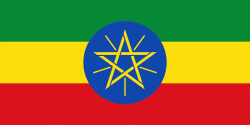Oromo language
Oromo ( or ; Oromo: Afaan Oromoo), in the linguistic literature of the early 20th century also called Galla (a name with a pejorative meaning and therefore rejected by the Oromo people ), is an Afroasiatic language that belongs to the Cushitic branch. It is native to the Ethiopian state of Oromia and Northern Kenya and is spoken predominantly by the Oromo people and neighboring ethnic groups in the Horn of Africa. It is used as a lingua franca particularly in the Oromia Region and northeastern Kenya.
With more than 36 million speakers making up 33.8% of the total Ethiopian population, Oromo has the largest number of native speakers in Ethiopia, and ranks as the second most widely spoken language in Ethiopia by total number of speakers (including second-language speakers) following Amharic. Forms of Oromo are spoken as a first language by an additional half-million people in parts of northern and eastern Kenya. It is also spoken by smaller numbers of emigrants in other African countries such as South Africa, Libya, Egypt and Sudan. Oromo is the most widely spoken Cushitic language and among the five languages of Africa with the largest mother-tongue populations.
Oromo serves as one of the official working languages of Ethiopia and is also the working language of several of the states within the Ethiopian federal system including Oromia, Harari and Dire Dawa regional states and of the Oromia Zone in the Amhara Region. It is a language of primary education in Oromia, Harari, Dire Dawa, Benishangul-Gumuz and Addis Ababa and of the Oromia Zone in the Amhara Region. It is used as an internet language for federal websites along with Tigrinya. Under Haile Selassie's regime, Oromo was banned in education, in conversation, and in administrative matters.
Ethnologue (2015) assigns five ISO codes to Oromo:
* Boranaa–Arsii–Gujii Oromo (Southern Oromo, including Gabra and Sakuye dialects), ISO code [gax]
* Eastern Oromo (Harar), ISO code [hae]
* Orma (Munyo, Orma, Waata/Sanye), ISO code [orc]
* West–Central Oromo (Western Oromo and Central Oromo, including Mecha/Wollega, Raya, Wello (Kemise), Tulema/Shewa), ISO code [gaz]
* Waata, ISO code [ssn]
Blench (2006) divides Oromo into four languages:
With more than 36 million speakers making up 33.8% of the total Ethiopian population, Oromo has the largest number of native speakers in Ethiopia, and ranks as the second most widely spoken language in Ethiopia by total number of speakers (including second-language speakers) following Amharic. Forms of Oromo are spoken as a first language by an additional half-million people in parts of northern and eastern Kenya. It is also spoken by smaller numbers of emigrants in other African countries such as South Africa, Libya, Egypt and Sudan. Oromo is the most widely spoken Cushitic language and among the five languages of Africa with the largest mother-tongue populations.
Oromo serves as one of the official working languages of Ethiopia and is also the working language of several of the states within the Ethiopian federal system including Oromia, Harari and Dire Dawa regional states and of the Oromia Zone in the Amhara Region. It is a language of primary education in Oromia, Harari, Dire Dawa, Benishangul-Gumuz and Addis Ababa and of the Oromia Zone in the Amhara Region. It is used as an internet language for federal websites along with Tigrinya. Under Haile Selassie's regime, Oromo was banned in education, in conversation, and in administrative matters.
Ethnologue (2015) assigns five ISO codes to Oromo:
* Boranaa–Arsii–Gujii Oromo (Southern Oromo, including Gabra and Sakuye dialects), ISO code [gax]
* Eastern Oromo (Harar), ISO code [hae]
* Orma (Munyo, Orma, Waata/Sanye), ISO code [orc]
* West–Central Oromo (Western Oromo and Central Oromo, including Mecha/Wollega, Raya, Wello (Kemise), Tulema/Shewa), ISO code [gaz]
* Waata, ISO code [ssn]
Blench (2006) divides Oromo into four languages:
Country
-
Ethiopia
Ethiopia, officially the Federal Democratic Republic of Ethiopia, is a landlocked country located in the Horn of Africa. It shares borders with Eritrea to the north, Djibouti to the northeast, Somalia to the east and northeast, Kenya to the south, South Sudan to the west, and Sudan to the northwest. Ethiopia has a total area of 1100000 km2. , it is home to around 113.5 million inhabitants, making it the 13th-most populous country in the world, the 2nd-most populous in Africa after Nigeria, and the most populated landlocked country on Earth. The national capital and largest city, Addis Ababa, lies several kilometres west of the East African Rift that splits the country into the African and Somali tectonic plates.
Anatomically modern humans emerged from modern-day Ethiopia and set out to the Near East and elsewhere in the Middle Paleolithic period. Southwestern Ethiopia has been proposed as a possible homeland of the Afroasiatic language family. In 980 BCE, the Kingdom of D'mt extended its realm over Eritrea and the northern region of Ethiopia, while the Kingdom of Aksum maintained a unified civilization in the region for 900 years. Christianity was embraced by the kingdom in 330, and Islam arrived by the first Hijra in 615. After the collapse of Aksum in 960, a variety of kingdoms, largely tribal confederations, existed in the land of Ethiopia. The Zagwe dynasty ruled the north-central parts until being overthrown by Yekuno Amlak in 1270, inaugurating the Ethiopian Empire and the Solomonic dynasty, claimed descent from the biblical Solomon and Queen of Sheba under their son Menelik I. By the 14th century, the empire grew in prestige through territorial expansion and fighting against adjacent territories; most notably, the Ethiopian–Adal War (1529–1543) contributed to fragmentation of the empire, which ultimately fell under a decentralization known as Zemene Mesafint in the mid-18th century. Emperor Tewodros II ended Zemene Mesafint at the beginning of his reign in 1855, marking the reunification and modernization of Ethiopia.
